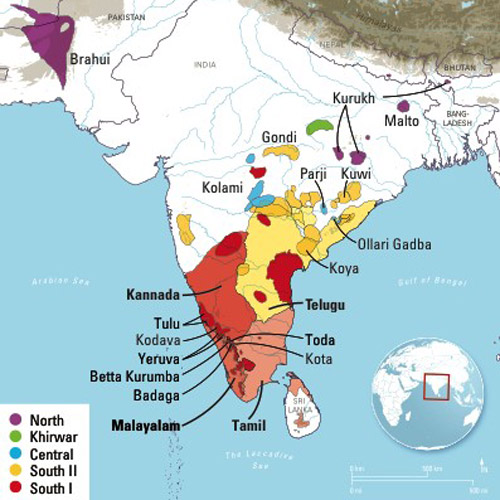The new and recent analysis of Dravidian language conducted by University of Bristol, it was found that some 4500 years ago this language used to be spoken by aprox. 220 million people around South Asia. The article in the journal “Royal Society Open Science” came up with some facts on this language concluding that there are not 1 or 2 but around 80 varieties of Dravidian language.
An international group of scientists had went on a survey around Southern and Central India along with surrounding countries in order to get some knowledge and facts of this language where they had some interactions with native people speaking this language.
If you move from Southern Asia to Afghanistan in the west and Bangladesh in the east, you will come to know that in this region there are at least 600 languages spoken. These native 600 languages belong to the 6 big language families, 3 of which are Dravidian, Sino-Tibetan and Indo-European.
As said above, there are further around 80 sub divisions in the Dravidian family, the 4 common and still spoken languages of which are- Kannada, Tamil, Malayalam and Telugu.
Just like Sanskrit, Tamil is also one of the classical language with the difference being unlike Sanskrit it is still being continued in modernised form having its own inscriptions, songs, poems, secular and religious texts.
The lead author of the Max Planck Institute for Science of Human History, Annemarie Verkerk, said that in order to understand the prehistory in Eurasia, it is important to know about the history of this language as it has a significant role in influencing other lingual groups.
Nothing is certain about this linguistic analysis, neither the geographical origin of it nor the time frame.
The research community came to the conclusion that the Dravidians are India’s native and they existed around 3500 years back which was even before the emergence of the Indo-Aryans.
In order to know about this language in detail the research team made an in-depth investigation of the historical relationships of the 20 varieties of Dravidian language. Advanced statistical methods were used by researchers in order to surmise the age and subgrouping of the 4,000-4,500 years old Dravidian lingual family.
The different statistical models studied by the researchers concluded that this language was consistently in use from then. Even the present age has similarity with the archaeological inferences which was the reason of diversification of Dravidian into the North, South and Central subcontinent of Asia,.
Another author also from the Max Planck Institute for the Science of Human History, Simon Greenhill said: “Here we have a really exciting opportunity to investigate the interactions between these people, and other cultural groups in the area such as Indo-European and Austro-Asiatic on one of the great crossroads of human prehistory.”
Another co-author of the study, Professor Fiona Jordan from the Department of Anthropology and Archaeology at the University of Bristol, said that the task of their lab is to focus on the emergence and cultural diversity of any language and this inclusion of Dravidian language in their research work is being very exciting for them.

